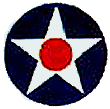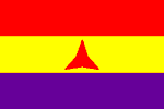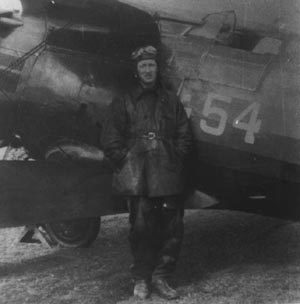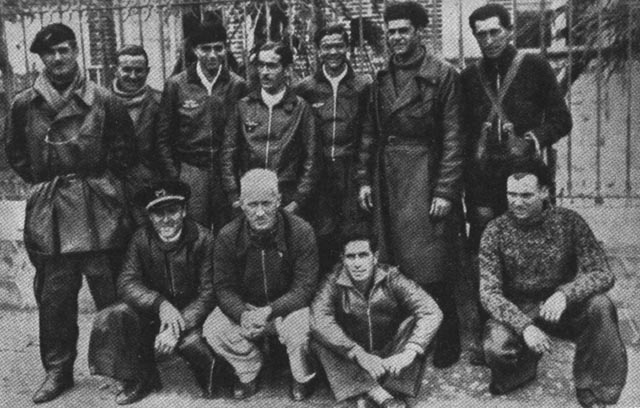United States of America


Harold Evans ‘Whitey’ Dahl
United States of America


Harold Evans ‘Whitey’ Dahl

29 June 1909 – 14 February 1956
Harold Dahl was born in Champaign, Illinois, on 29 June 1909.
Dahl joined the U.S. Army Air Corps in 1933, during which time he was commissioned to Second Lieutenant.
In February 1936, Dahl was kicked out of the army because of compulsive gambling and civil court convictions.
He then became a freelance pilot for a while before getting into trouble with some Los Angeles based gamblers.
He fled to Mexico City where he flew airships, charter flights and ferried aircraft to Vera Cruz for shipment to the Spanish Republic.
He served as a volunteer on the Government side during the Spanish Civil War and used the nom de guerre Hernando Diaz Evans.
By February 1937, capitán Ramón Puparelli Francia was well enough (he had been wounded in combat on 21 October 1936) to be given command of the first two Spanish I-15 escuadrillas. The short-lived grupo was named Grupo de Caza No 16 but both escuadrillas were to operate virtually independently.
Andrés García La Calle was put in command of the 1a Escuadrilla. Initially it comprised three elements. The 1a Patrulla consisted of La Calle, José Calderón, Ramón Castañeda di Campo and Ben Leider, the 2a Patrulla comprised of Jim Allison, Frank Tinker, Dahl and José ‘Chang’ Sellés and the 3a Patrulla was made up of Luis Bercial, Esteban Ortiz, José Riverola Grúas and Gerardo Gil Sánchez (who joined the unit on 10 February).
Capitán Roberto Alonso Santamaría took command of the new second Spanish I-15 escuadrilla, the 2a Escuadrilla, which was established at Los Alcázares and San Javier. From there they moved to El Soto airfield, again on the Madrid front. The new escuadrilla comprised tenientes Rafael Robledano Ruiz, Juan Comas Borrás (posted in late February), Antonio Blanch Latorre, Ricardo Rubio Gómez, Mariano Palacios Menéndez, Ángel Álvarez Pacheco, Justo García Esteban and Hipólito Barbeito Ramos, sargentos Manuel García Gascón, Alfonso Calvo Ortiz, Cándido Palomar Agraz and Rafael Magriña Vidal and Uruguayan teniente Luis Tuya.
On 7 February, the 1a Escuadrilla moved to the old Hispano-Suiza aerodrome in Guadalajara. They began operations at El Jarama, where their activities were outstanding, but their losses heavy; José Calderón, Ben Leider and Luis Bercial were killed, while Jim Allison and Dahl were shot down but survived.

In the early morning on 18 February, two Nationalist Ro.37s (flown by Spanish pilots) took off, followed by three Ju 52/3ms escorted by the Spanish Patrulla Azul and the Italian Fiat Group (totally 25 CR.32 including the Spanish). When they arrived over the front at Jarama, the CR.32s turned so that they were patrolling parallel to the front, while a large formation of Polikarpov fighters waited on the other side. When the Ro.37s and Ju 52/3ms were safe and returning, capitán Joaquín García Morato broke formation and, followed by teniente Julio Salvador Díaz-Benjumea and capitán Narciso Bermúdes de Castro, launched himself into Soviet fighters near Arganda. Disregarding recent orders restricting them from engaging superior numbers of enemy aircraft, Italian pilots tenente Corrado Ricci, tenente Enrico Degli Incerti, capitano Guido Nobili and Fiacchino went to the assistance of their Spanish comrades by leading their respective flights against the large Republican formation of Polikarpov fighters. Finally, the entire group took part in the battle, fighting a reportedly 21 I-15s and 18 I-16s, and the Italians claimed for four ”Curtiss fighters” destroyed and four probables, as well as four Ratas destroyed and one probables. One I-16 and two probable I-15s were claimed by tenente Degli Incerti while sergente maggiore Silvio Costigliolo claimed an I-15 in the Arganda area. Sergente maggiore Guido Presel claimed two I-15s and a probable and sergente maggiore Brunetto di Montegnacco claimed two I-16s. Among the Spaniards, capitán Morato, who returned with damage to his fighter, was credited with an I-15 and another as a probable while teniente Salvador was credited with and I-16 and a second fighter as a probable.
The Italians suffered no losses during this action, and only a solitary pilot was forced to make an emergency landing after he was wounded; the damage to his CR.32 was quickly repaired.
Tenente Degli Incerti described the combat:
“We were on the return leg of an escort mission, and having made sure that our bombers were safe, we had the airfield in sight and prepared to land. It was at that very moment that the three Spanish CR.32 pilots following us, but still flying over enemy territory, decided to take on a large Soviet formation. Although the enemy aircraft were still some distance away, we performed a hasty 180-degree turn at full throttle and joined the fray. All the Italian fighter flights following suit, despite us having orders only to intervene following provocation – our duty was to fight as courageously as possible to the end.Reportedly this battle was fought at 11:00 against at least the I-15s of the Escuadrilla La Calle and Escuadrilla José (the Escuadrilla led by Ivan Kopets) and the I-16s from Escuadrilla Kolesnikov (1a/21). The Republican pilots reported meeting six ”Junkers” and 50 fighters (other sources states 85 (!) Heinkel He 51s) over the front. Immediately the Escuadrilla went into a tight horizontal circle (”Lufbery circle”). The first enemy aircraft fired randomly at the I-15s as they dived past the Escuadrilla’s defensive pattern. Unwillingly to challenge the Republican fighters, the remainder of the Nationalist pilots followed suit, executing a single strafing pass, and then flying lazily below the I-15s in hopes of enticing a few green Republican pilots away of the defensive protection. Ben Leider took the bait and started down after one of the easy-looking targets, only to attract three enemy fighters on his tail. As Frank Tinker peered over his shoulder during the swirling melee of aircraft, he saw Leider’s I-15 to shudder as the CR.32s flashed past. Tinker’s heart sank as he noticed Leider veer toward friendly territory in a shallow dive. Twice, Leider tried to land his fighter in a small field before slamming into the side of a hill, killing him.
Once we had engaged the enemy, both sides formed a long line of aircraft, and this was turning, banking and circling. The fighters alternated in this single file trail, with two or three “Reds” for every Nationalist. It was as if this formation had been planned. Many tracer rounds flashed through the sky from the aircraft, turning the dogfight into an infernal ballet. Smoke trails of death suddenly appeared, and the long line broke into smaller rows.
The battle threw up numerous small skirmishes that ended inconclusively. Despite being outnumbered, we legionnaires stood together, compact, protecting each other. All of a sudden in the centre of the melee an aircraft caught fire and a parachute opened. The former fell away and crashed to the ground, while the latter floated away to safety. A “Red” had been shot down. Four of his comrades, fearing that we'd shoot at the pilot, circled him for his protection. Two CR.32s engaged them. This turn of events split the battle into two groups, within which fierce fighting continued.
The “Curtiss fighter” section then broke off their attack, unable to defeat our concentrated gunfire. They tried to escape, but this move failed and two of the stubby fighters fell in flames.
Thirty minutes into the battle, thousands of bullets had crossed the sky over Villaconejos. By now the revolving aircraft and chatter of the guns had diminished. The fighting faded slowly away, and within a short time we remained as the sole masters of the sky over the Jarama front.”
On 20 March 1937, the 1a Escuadrilla (”Escuadrilla La Calle”) took part in the last aerial combat during the battle of Guadaljara. They took off in four patrols, led by Andrés García La Calle, Dahl, Frank Tinker (CA-056) and the Guatemalan pilot Miguel García Granados, and were soon involved with three bombers and 20 Fiats. Granados patrol was jumped by the Fiats, which had been patrolling in a higher altitude, and in the first hail of bullets Granados was shot down. Tinker gained his second victory at 17:00 (M. Scala KIA?), and from the two squadrons of fighters taking part five Fiats were destroyed.
The Italians reported that a patrol of four Fiat fighters under the command of Capitano Mario Viola had taken off from El Burgo de Osma in the afternoon and subsequently bounced two I-15s flying at low altitude in the vicinity of Almadrones. Sergente Maggiore Brunetto di Montegnacco shot one of the aircraft down in flames in spite of his opponent’s violent evasive action, the pilot taking to his parachute and being captured. Montegnacco’s victim was Miguel Garcia Granados, who suffered burns to his face and one hand and he was captured (he later returned in a prison exchange).
Granados (1896-1968) was a former Colonel in the Guatemalan Air Force who had done a famous goodwill flight in 1929 from Washington DC to Guatemala. He had previously commanded the Guatemalan air force, with the rank of colonel, between 1930 and 1933. He had also served with the Paraguayan Air Force in the Gran Chaco War.
During the spring of 1937, the second group of Soviet volunteers was sent to Spain. The group was led by Kapitan Ivan Yeremenko and included Leitenant Mikhail Yakushin ('Carlos Castejón'), Leonid Rybkin, Mikhail Petrov, Sergei Shalyganov and Ivan Karpov.
They travelled through France with Dutch passports - they didn't speak either foreign language fluently!
Not without adventures the Soviet fliers arrived at their destination on 31 May 1937.
Arriving with them where Spanish Republican pilots who had been undergoing fighter training at the Soviet flight school near Kirovabad.
At the same time as this second group of Soviet volunteers arrived, another batch of 31 Chatos arrived from the Soviet Union, taking the total number supplied to the Republicans to 116. These new fighters greatly enhanced the strength of the I-15 Grupo.
After arrival, an escuadrilla of I-16 fighters, designated 1a Escuadrilla of Grupo de Caza No 21 (1a/21), was organized under the command of Kapitan Ivan Yeremenko while Andrés García La Calle was to undergo further training in the Soviet Union. Initially this unit performed defensive duties from Cartagena and Elche to Alicante, protecting Republican warships and cargo vessels from insurgent air raids. Following the redeployment of the I-16s to the north, and the poor quality of the latest batch of I-16s to reach Spain and during a period of forced inaction in June 1937, half of the group was sent to Los Alcazares airfield, where it was re-equipped with the new I-15s. The new escuadrilla was later designated 1a/26 and commanded by Kapitan Ivan Yeremenko.
The Russian pilots in this escuadrilla included Yevgeniy Antonov, Ivan Karpov, Georgii Masterov, Mikhail Petrov, Leonid Rybkin, Anatoly Serov, Nikolai Sobolev, Sergei Shalyganov and Mikhail Yakushin. The 1a/26 was completed by pilots of different origin; three Spanish, two Austrian, two Americans (one of them was Dahl) and the Yugoslav Bozidar Petrovich. It is also known that Leitenant Leonid Rybkin served as a Patrulla leader and Dahl was part of this Patrulla. Another Patrulla leader was Yevgeniy Antonov.
The escuadrilla, was based at El Soto, had already become operational two days after the Brunete campaign began and where aviation played considerable role. The insurgents increased their presence in the air battles by using German and Italian units armed with the newest aircraft. Nevertheless, Soviet fliers gained considerable success there, claiming numerous enemy aircraft shot down.
On 13 July, Feldwebel Peter Boddem of 2.J/88 (Bf 109B) claimed an I-16 in the course of an hour-long air battle which also saw Feldwebel Braunschweiger (6-13) and Oberfeldwebel Fritz Hillman claim an unconfirmed I-16 each.
It is possible that one of these claims (possibly Boddem) was Dahl, who was shot down and taken prisoner during the day.
Dahl was tried and sentenced to death together with radio/gunner Aleksey Fedorovich Cherkasov, who had been shot down in an SB the day before. The sentence was commuted and he remained in a Spanish prison until 1940, when he was allowed to return to the US.
Dahl is reputed to have claimed 5 biplane victories during his time in Spain.
When he returned to the US he found out that his wife, Edith, had divorced him.
Dahl spent several months of rest a relaxation before going to Canada to join the Royal Canadian Air Force where he became a commissioned officer.
He served with the RCAF with distinction throughout WW II and remarried.
After the war, Dahl was cashiered out of the RCAF for selling equipment, which had not been declared surplus.
He went to Venezuela for a short time before signing on to join Swissair in which he flew the Geneva to Paris route.
He got into trouble again in 1953 when a gold bar turned up missing on one of his flights. He was arrested and sat in prison for months awaiting trial.
He was released during his appeal and ordered to leave Switzerland.
Dahl returned to Canada and became a bush pilot.
On 14 February 1956 Dahl died in a fatal crash in the DC-3 he was piloting near Fort Chimo, 800 miles north of Quebec, Canada.
Claims:
| Kill no. | Date | Time | Number | Type | Result | Plane type | Serial no. | Locality | Unit |
| 1937 | |||||||||
| ? | ??/??/37 | 1 | CR.32 | Destroyed | I-15 | La Calle Escuadrilla | |||
| ? | ??/??/37 | 1 | He 51 | Destroyed | I-15 | La Calle Escuadrilla |
Biplane victories: 5 destroyed.
TOTAL: 5 destroyed.
Sources:
Airmen without a portfolio: U.S. mercenaries in civil war Spain - John Carver Edwards, 2003 Global Book Publisher, ISBN 1-59457-175-9
Air War over Spain - Jesus Salas Larrazabal, 1974 Ian Allan Ltd, Shepperton, Surrey, ISBN 0-7110-0521-4
Fiat CR.32 Aces of the Spanish Civil War - Alfredo Logoluso, 2010 Osprey Publishing, Oxford, ISBN 978-1-84603-983-6
Flyers of Fortune
Legionaire Ace – Julius R. Gaal, 1972, Aero Album Volume 5 Number 1 Spring 1972
Några leva än - F. G. Tinker, 1939 T. V. Scheutz Bokförlag AB, Stockholm
Polikarpov Fighters in action Pt. 1 - Hans-Heiri Stapfer, 1995 Squadron/Signal Publications, Carrollton, ISBN 0-89747-343-4
Spanish Republican Aces – Rafael A. Permuy López, 2012 Osprey Publishing, Oxford, ISBN 978-1-84908-668-4
Stars & Bars - Frank Olynyk, 1995 Grub Street, London, ISBN 1-898697-17-5
Wings Over Spain - Emiliani Ghergo, 1997 Giorgio Apostolo Editore, Milano
Additional information kindly provided by Simon Buckley, Eugenio Costigliolo and Mikhail Zhirokhov.


